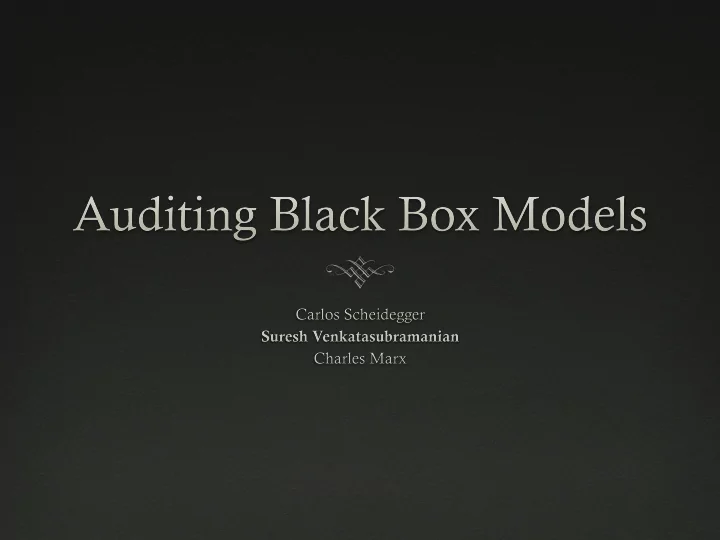

Make sure we can query black box algorithms http://www.bloomberg.com/graphics/2016-amazon-same-day/ Auditing Black Box Models
Training vs Testing No access to training Training data or algorithm data ✔ Test data ✖ Auditing Black Box Models
How can we understand a model If we use a “simple” model we can interpret it directly. Decision trees Linear classifiers SLIM (Sparse Linear Interpretable Models) Auditing Black Box Models
Simple models are hard Paul Raccuglia, Katherine C. Elbert, Philip D. F. Adler, Casey Falk, Malia B. Wenny, Aurelio Mollo, Matthias Zeller, Sorelle A. Friedler, Joshua Schrier, and Alexander J. Norquist. Machine- learning-assisted materials discovery using failed experiments. Nature, 533: 73 - 76, May 5, 2016. http://dx.doi.org/10.1038/nature17439 Auditing Black Box Models
Research Question Given a black box function Y = f ( x 1 , . . . , x n ) Determine the influence each variable has on the outcome How do we quantify influence How do we model it (random perturbations?) How do we handle indirect and joint influence Auditing Black Box Models
Direct vs Indirect Influence Auditing Does a feature (or group of features) directly influence the outcome? E.g a feature used in a decision tree Intervention: Replace feature with random noise and see how much model accuracy degrades. Auditing Black Box Models
Direct vs Indirect Influence Auditing Does a feature (or group of features) in directly influence the outcome? E.g zipcode as a proxy for race? Intervention: Direct perturbation no longer works, because more than one variable carries the desired signal. Auditing Black Box Models
Information content and indirect influence the information content of a feature can be estimated by trying to predict it from the remaining features If the removed feature can’t be predicted from the remaining features, then the information from that feature can’t influence the outcome of the model. Auditing Black Box Models
Information content and indirect influence the information content of a feature can be estimated by trying to predict it from the remaining features Given variables X, Y that are correlated, find Y’ conditionally independent of X such that Y’ is as similar to X as possible . Auditing Black Box Models
Gradient Feature Audit For each feature, 1. Remove indirect influence of feature on other features in data 2. Run model on modified test data 3. Feature influence = original accuracy – resulting accuracy Example: Auditing Amazon model: Feature to remove: race Eliminate (obscure) influence of race on zipcode Auditing Black Box Models
Gradient Feature Audit For each feature, 1. Remove indirect influence of feature on other features in data 2. Run model on modified test data 3. Feature influence = original accuracy – resulting accuracy All our measures of influence are Example: Auditing Amazon model: relative to a fixed Feature to remove: race model. Eliminate (obscure) influence of race on zipcode Auditing Black Box Models
How do we remove indirect influence? 0.008 0.006 0.004 0.002 0.000 200 400 600 800 Hypothetical SAT scores Merge conditional distributions of obscured feature based on eliminated feature. Auditing Black Box Models
How do we remove indirect influence? 0.008 0.006 0.004 0.002 0.000 200 400 600 800 Hypothetical SAT scores This will ensure that F-test will fail to tell them apart (provably*) Auditing Black Box Models
How do we remove indirect influence? 0.008 0.006 0.004 0.002 0.000 200 400 600 800 Hypothetical SAT scores Need different approaches for categorical and numerical removed and eliminated variables. Auditing Black Box Models
Representation matters! Should race be categorical or numerical? Should it be “white/non-white” or multi-valued? These issues matter! For more, see https://arxiv.org/abs/1802.04422 https://github.com/algofairness/fairness-comparison Auditing Black Box Models
Recommend
More recommend